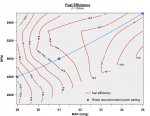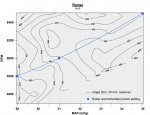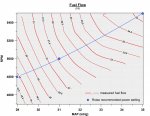As many already know, I am flying an AC20 ArrowCopter with a Rotax 914 and a constant speed prop. Back when I did the test flights for the certification process, I did an exhaustive suite of test flights on cruise performance. Just recently I revisited the results and a few questions popped up.
Here is the fuel efficiency calculated from fuel flow and IAS for a range of power settings.

The way to read this graph is to pick a MAP (e.g. 30 inHg) and an RPM value (e.g. 5200 rpm). Near the point, where the vertical line from 30 inHg and the horizontal line from 5200 rpm cross, is a red line labelled "14.6". This means that at a power setting of 30"/5200 you need 14.6 liters of fuel for every 100 km travelled (corresponding to 17 mpg, in imperial units).
Rotax, in their engine manual for the 914, recommend only three power settings. They are marked as the blue dots in the graph and correspond to 35"/5500, 31"/5000 and 29"/4800. It is probably safe to infer that any power setting on the blue line connecting those three dots will also be OK according to Rotax.
As you can see from the chart, not surprisingly, the highest fuel economy is achieved at high MAP and low RPM. Ideally, I would want to cruise at 35"/5000 and would only use 13.6 liters per 100 km. At which point I would be zipping along at 175 km/h with a range (including 30 min reserve) of 455 km.
The problem is that, according to Rotax I would be overboosting the engine. However, I have received various indications from knowledgable people that Rotax is using a veeery conservative margine of error for the recommended power settings.
My question, therefore, is this: does anybody know how far into the regime of high MAP and low RPM the Rotax 914 can safely be flown without damaging the engine in the long run? And how would I know that I am getting close to pre-detonation ("knocking")? Would that show up on the EGT gauges?
Thanks for any comments, -- Chris.
P.S.: For completenes' sake I attached the other three contour plots which show fuel flow, range and endurance as a function of power setting.
All values are quoted at the MTOW of 560 kg and a density altitude of 500 feet.
Here is the fuel efficiency calculated from fuel flow and IAS for a range of power settings.

The way to read this graph is to pick a MAP (e.g. 30 inHg) and an RPM value (e.g. 5200 rpm). Near the point, where the vertical line from 30 inHg and the horizontal line from 5200 rpm cross, is a red line labelled "14.6". This means that at a power setting of 30"/5200 you need 14.6 liters of fuel for every 100 km travelled (corresponding to 17 mpg, in imperial units).
Rotax, in their engine manual for the 914, recommend only three power settings. They are marked as the blue dots in the graph and correspond to 35"/5500, 31"/5000 and 29"/4800. It is probably safe to infer that any power setting on the blue line connecting those three dots will also be OK according to Rotax.
As you can see from the chart, not surprisingly, the highest fuel economy is achieved at high MAP and low RPM. Ideally, I would want to cruise at 35"/5000 and would only use 13.6 liters per 100 km. At which point I would be zipping along at 175 km/h with a range (including 30 min reserve) of 455 km.
The problem is that, according to Rotax I would be overboosting the engine. However, I have received various indications from knowledgable people that Rotax is using a veeery conservative margine of error for the recommended power settings.
My question, therefore, is this: does anybody know how far into the regime of high MAP and low RPM the Rotax 914 can safely be flown without damaging the engine in the long run? And how would I know that I am getting close to pre-detonation ("knocking")? Would that show up on the EGT gauges?
Thanks for any comments, -- Chris.
P.S.: For completenes' sake I attached the other three contour plots which show fuel flow, range and endurance as a function of power setting.
All values are quoted at the MTOW of 560 kg and a density altitude of 500 feet.
Attachments
Last edited:



